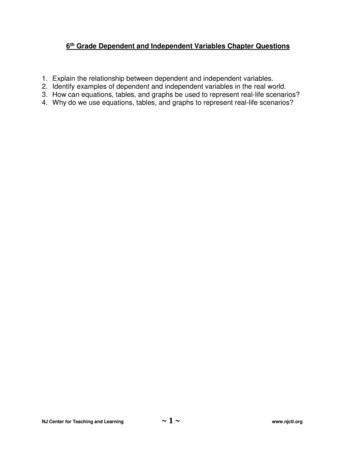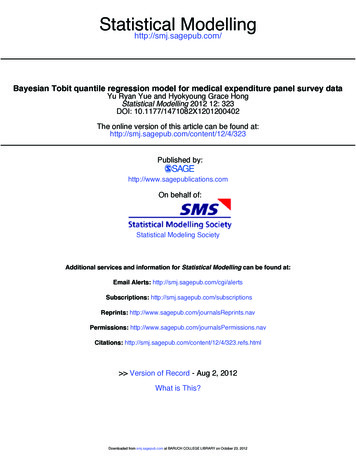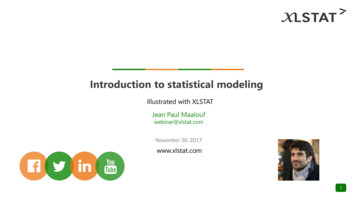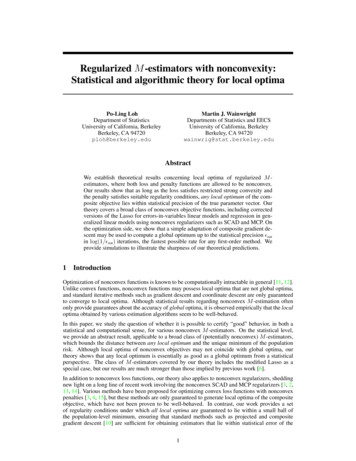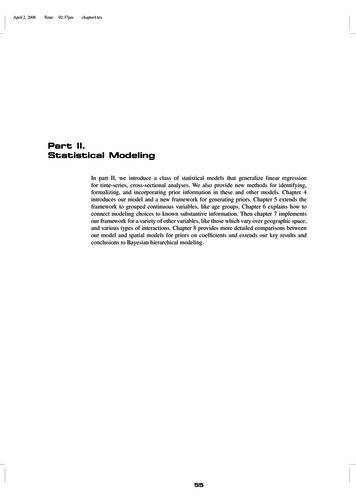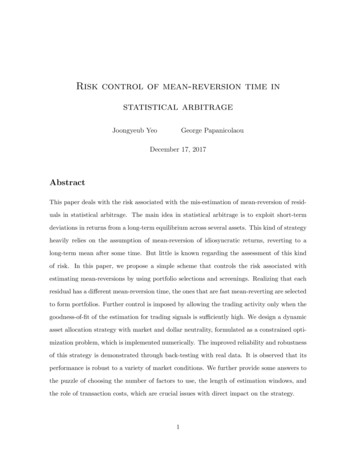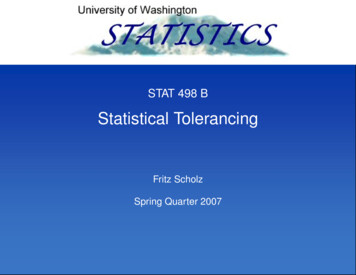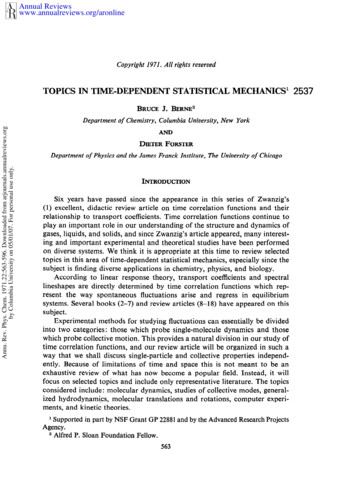
Transcription
Annual . All rights reserved1TOPICS IN TIME-DEPENDENTSTATISTICALMECHANICS25372BRUCEJ. BERNEAnnu. Rev. Phys. Chem. 1971.22:563-596. Downloaded from arjournals.annualreviews.orgby Columbia University on 05/01/07. For personal use only.Departmentof Chemistry, ColumbiaUniversity, NewYorkDIETERFORSTERDepartmentof Physlcs and the JamesFranckInstitute,The University of ChicagoINTRODUCTIONSix years have passed since the appearance in this series of Zwanzig’s(1) excellent, didactic review article on time correlation functions and theirrelationship to transport coefficients. Time correlation functions continue toplay an important role in our understanding of the structure and dynamics ofgases, liquids, and solids, and since Zwanzig’s article appeared, manyinteresting and important experimental and theoretical studies have been performedon diverse systems. Wethink it is appropriate at this time to review selectedtopics in this area of time-dependent statistical mechanics, especially since thesubject is finding diverse applications in chemistry, physics, and biology.According to linear response theory, transport coefficients and spectrallineshapes are directly determined by time correlation functions which represent the way spontaneous fluctuationsarise and regress in equilibriumsystems. Several books (2-7) and review articles (8-18) have appeared onsubject.Experimental methods for studying fluctuations can essentially be dividedinto two categories: those which probe single-molecule dynamics and thosewhich probe collective motion. This provides a natural division in our study oftime correlation functions, and our review article will be organized in such away that we shall discuss single-particleand collective properties independently. Because of limitations of time and space this is not meant to be anexhaustive review of what has now become a popular field. Instead, it willfocus on selected topics and include only representative literature. The topicsconsidered include: molecular dynamics, studies of collective modes, generalized hydrodynamics, molecular translationsand rotations, computer experiments, and kinetic theories. Supported in part by NSFGrant GP22881 and by the AdvancedResearch ProjectsAgency.2 Alfred P. Sloan Foundation Fellow.563
Annual Reviewswww.annualreviews.org/aronline564BERNE & FORSTERMOLECULARDYNAMICSAnnu. Rev. Phys. Chem. 1971.22:563-596. Downloaded from arjournals.annualreviews.orgby Columbia University on 05/01/07. For personal use only.Electroniccomputers have advanced to such a degree that Newton’sequations of motion can now be integrated for a fairly large assembly ofinteracting particles. This method, now commonlycalled molecular dynamics,is particularly useful for study of condensed phases of matter. Features common to all molecular dynamics experiments to date are the following: (a)The sYstems are finite N 1000; (b) The interaction potential is pairwiseadditiveNV(I .N) .i j 1wherethe pair potential (r) has a finite range r0 such that for r ro, (r)(c) Newton’s equations of motiondV m - t (r, ),"V, --dr dt- are solved by finite difference techniques with time steps At between l0and 10 xs sec; and (d) The positions, velocities, and accelerations are storedon magnetic tape.Computer experiments on equilibrium liquids all have, in addition, thefollowing features in common:(a) The N particles are contained in a cubicbox of edge L to; (b) The initial state (initial positions and momenta)sampled such that the momenta are distributedaccording to the Maxwelldistribution at a given temperature and the positions are sampled such that theinitial configuration corresponds to a quite large value of the Boltzmannfactorexp - (flV(1 . , N)}; i.e. the system is in a probable state for a memberan equilibrium ensemble; and (c) The equations of motion are solved subjectto periodic boundary conditions.A number of comments are in order. N and V ( a) a re c hosen t o g ivethe number density N/V of the physical system under study. Sampling of theconfiguration is quite complicated and we refer the reader to the literaturefor a more detailed discussion of this subject.The equations of motion are solved subject to the initial state together withperiodic bondary conditions: the latter meansthat if (x, y,, z,) is the positionof particle i in the box, there are 26 periodic images at (x, L L,0, y, L L,0,z L,0). The particles in the box interact with the periodic images within,their range. Consequently when a particle leaves the box through one side,its image enters through the opposite side, which thus preserves the number ofparticles in the box. These conditions eliminate strong surface effects andessentially simulate an infinite system. Nevertheless, periodic boundary conditions have the following limitations:1. Because the number of particles in the box is constant, it is impossibleto study thermodynamic states in which thermal fluctuationshave
Annual T STATISTICALMECHANICS565Annu. Rev. Phys. Chem. 1971.22:563-596. Downloaded from arjournals.annualreviews.orgby Columbia University on 05/01/07. For personal use only.correlation lengths of the order of the box size as they do in the criticalregion.2. The time scale is limited to times shorter than L/C, where C is thevelocity of sound. For times longer than this a disturbance which arisesin one region of the box can traverse the box and enter through theopposite side, which thus leads to spurious recurrences.3. The collective properties that can be studied are limited to discretewavevectors2rrq--- nwith minimum wavenumber2 rq z-"This limits the kinds of questions that can be investigateddynamics.The computer output is then the sequence of statesby molecularro,., r,,., r, through which the system passes in the course of time. Here Fj is the state ofthe system (all positions and momenta) after the jth time step; i.e. at timet jAt. The output is consequently a set of discrete points in phase spaceand Mis the total number of iterations done in the computations.The computer output may be regarded as a dynamical movie of the manybody system and can be converted into a movie via computer animationtechniques. This has been done by several investigators (Harp, Berne, Paskin,Rahman, and Fehder). Such sources are a particularlyconvenient way topresent the enormous data so that the viewer can get some insight into thedynamical behavior of molecules in condensed media. For example, as thestrength of the noncentral potential is increased in polyatomic liquids,the movie shows how the rotational motion of molecules becomes more hindered. Such movies give the viewer an opportunity for discoveries by serendipitythat exist in connection with laboratory experiments.These solutions are checked for consistency in the following way:1. At intermediate times, say j, the velocities of the particles are reversedand the calculation proceeds j steps. The final state should rigorouslycoincide with the initial state (microscopic reversibility) and any deviation reflects round-off error.2. The total energy and momentumis computed. Since these are constantsof the motion any variation in the total energy and momentumreflectsinaccuracies in the solution.3. The mean kinetic energy per particle is computed and its variation intime is monitored. This should fluctuate about the average desired
Annual Reviewswww.annualreviews.org/aronline566BERNE & FORSTER"temperature." Any systematic drift in this quantity reflectsthat the system is not at equilibrium.4. An order parameterthe factAnnu. Rev. Phys. Chem. 1971.22:563-596. Downloaded from arjournals.annualreviews.orgby Columbia University on 05/01/07. For personal use only.1 N e(t) i ’ # cos Kx jis monitored, where K is a vector in the reciprocal lattice of the corresponding solid. If the system is ordered (t) should fluctuate aroundN - 1, whereas if it is a liquid (t) should fluctuate around zero.Note that if 1. checks out it does not by itself imply that the solution isaccurate. The numerical algorithm mayitself be reversible in time. All 1. does ischeck round-off error. Weregard I. as an important check on the accuracy ofthe solution. Manyof the studies reported here do not report the degree towhich the constants of the motion are conserved, so that we cannot alwaysassess their trustworthiness. In every case, the temperature fluctuates aroundits equilibrium values, likewise for the order parameter. All these systems are inequilibrium.The computer generates the state (1"o,.,rj . I’M) through which thesystem passes in the course of time so that any property A(P ) can be determined at each of these states (A0,., Ay . AM)where A; A(I’ ).In classical statistical mechanics bulk properties of an isolated system aregiven by infinite time averages(A) lim dtA(r )whereI’ is the state of the mechanicalsystem at time t. In addition, the linearresponse of a system to "weak probes" is given in terms of the time correlationfunction(A(O)A(t)) llmT-- o dtA(I t)A(I’, )The computer unfortunately generates a part of the phase orbit, and onlydiscrete points at that. Thus the infinite time averages must be replaced by thefinite sums1 M(A(O)A(t))1M--n A A ,,t nAtAveragingover finite rather than infinite times gives rise to errors in the computed averages. Zwanzig & Ailawadi (19) estimated these errors on the basisof a Gaussian stochastic model of the fluctuations. They found that the errors
Annual Reviewswww.annualreviews.org/aronlineAnnu. Rev. Phys. Chem. 1971.22:563-596. Downloaded from arjournals.annualreviews.orgby Columbia University on 05/01/07. For personal use only.TIME-DEPENDENT STATISTICALMECHANICS567grow with the time - and with a decrease in M. They also find that the singleparticle (incoherent) properties can be determined with greater accuracy thanthe collective (coherent) properties.In what follows, we present a survey of the results obtained to date bymolecular dynamics. Although our review may be incomplete it is hoped thatthe interested reader will consult the papers cited to find references to the workomitted here.Computers have come of age in statisticalmechanics. Alder & Wainwright(20-24) introduced the method of molecular dynamics. Their pioneering studiesof the equilibrium properties, the collision rate, and the velocity autocorrelation function in hard sphere and square well fluids set the stage for whatfollowed. Since their work deals exclusively with discontinuous potentials itforms a self-contained set of studies which can be reviewed separately.Aider & Wainwright (20) first studied systems containing 100 hard sphereand 100 square well molecules respectively.In this preliminary work theyconsider the collision rate, pressure equation of state, and velocity correlationfunction of hard sphere and square well fluids at a sequence of densities.Moreover, they compute the Boltzmann H function and show that it decaysmonotonically in time even at high densities and that it relaxes to equilibriumin 3 or 4 mean collision times. This preliminary work has two importantconclusions: at high densities the velocity autocorrelation function becomesnegative due to reflection of the spheres off their nearest neighbors (cageeffect), and the results for the collision rate and diffusion coefficients agreewith the Enskogg equation up to quite high densities. The methods used byAlder & Wainwright are somewhat different than those outlined here becausethey are dealing with discontinuous potentials. Alder reviews these methods,analyzes their limitations, and gives an excellent summaryof the subject in(21).Alder & Wainwright (22) have investigatedhow many hard spheres areneeded to adequately represent an infinite system of hard spheres. They studythe differences in the results of molecular dynamics in systems containing from4 to 500 hard spheres and also study the effects of the periodic boundaryconditions, concluding from this work that periodic boundary conditions causethe least errors of all boundary conditions tried and give the most realisticresults. Moreover,they find that as few as 100 particles will accurately describea hard sphere fluid. They reaffirm their preliminary finding that the Enskoggequation is quite adequate for the description of the collision rate up to fiighdensities.The same authors (23) studied a two-dimensional system containing 870hard discs. This study is perhaps one of the most important in moleculardynamics because it shows that there is a fluid-solid region with a van derWaals loop. The density change across the transition is 4 7o and the corresponding entropy change is small. This first order phase transition is studiedin some detail by Hoover & Alder (25). They discuss the results in termscommunal entropy and give the number dependence of the pressure.
Annual Reviewswww.annualreviews.org/aronlineAnnu. Rev. Phys. Chem. 1971.22:563-596. Downloaded from arjournals.annualreviews.orgby Columbia University on 05/01/07. For personal use only.568BERNE & FORSTERAlder (24) studied an equimolar mixture of 500 hard spheres, with a radiusratio of 3 to 1. Two important conclusions of this work are: 1. the PercusYevick equation, as generalized by Lebowitz to mixtures, agrees well withdynamics; and 2. changes in the thermodynamic functions on mixing atconstant pressure are quite small in spite of the large radius ratio. This latterobservation leads Alder to conjecture that excess thermodynamic propertiesare muchmore sensitive to the attractive forces than to differences in the sizesof molecules. Muchof the preceeding work is reviewed by Alder in (26, 27).Dymond& Alder (29) have tested a simple theory of transport in densegases which they call a van der Waals theory of transport. Their basic assumption is that the transport coefficients of real fluids can be determined from theEnskogg equation. For this purpose it is necessary to know the pair correlation function at contact, i.e. at the hard core diameter. The authors determinethis from molecular dynamics. The hard core diameter a is determined for theinert gases, from the actual equation of state data, by fitting this data to thevan der Waals equation. This yields a temperature-dependentdiameter.The transport coefficients so obtained agree with experiment to within 10 7o inboth absolute value and temperature dependence.In addition, Dymond & Alder (29) have determined the self-diffusioncoefficient for a hard core fluid from molecular dynamics as a function of thehard core diameter. This data was inverted to give the diffusion coefficient as afunction of temperature by using the temperature dependence of the hardcore diameter determined above. This procedure bypasses the Enskogg equation with its concomitant assumptions of molecular chaos and gives diffusioncoefficientsin qualitativeagreement with experimental measurements onliquid methane from the critical point down to near the normal boiling pointalong the liquid branch of the liquid-vapor coexistence curve.Alder & Wainwright (28, 30, 31) have made a detailed study of the timedependence of the velocity autocorrelation function over a very long time in twodimensional hard sphere fluids. The number dependence of the self-diffusioncoefficient isO v D[1 - 2/N]and the velocity autoeorrelation function shows a small positive deviationfrom exponential behavior at low density, but the diffusion coefficient, whencorrected for the N dependence, is in excellent agreement with the prediction ofthe Boltzmann quation. Also in this study (28) they detected velocity correlations at surprisingly long times. Although they could not explain this longtime persistence, they noted that such effects could lead to as muchas a 20 oenhancement of the diffusion coefficient. The authors then showed (30) thatthe long time tail in the velocity correlation function (vcf) extends out to morethan 20 to 30 mean collision times (tact) whereas there is a fast initial decayof the vcf of the order 1.5 mct. This effect is number dependent O(I/N),and D increases by nearly 10 o in going from 108 to 500 hard cores in thehigh density region. They conjecture that the long time persistence in the
Annual Reviewswww.annualreviews.org/aronlineAnnu. Rev. Phys. Chem. 1971.22:563-596. Downloaded from arjournals.annualreviews.orgby Columbia University on 05/01/07. For personal use only.TIME-DEPENDENT STATISTICALMECHANICS569vcf is due to cooperative motions and test this hypothesis by studying theflow pattern around a moving hard disc. They find that a diffusing particleexperiences a positive pressure in front and a negative pressure behind with aconcomitant double-vortex flow of neighboring particles. This vortex motionbrings particles into the region behind the diffusing particle, which therebyprevents its return and leads to an enhancementof the diffusion coefficient.Alder & Wainwright (31) present an elementary hydrodynamic theory forthe long time dependence of the vcf which predicts that the long time tailgoes as-dl2 b(t) oz (rlst/mp)where r/s, mp, d are the shear viscosity, mass density, and dimension of thesystem respectively. This conclusion is borne out by the hard disc calculationwhere d 2. From the Kubo relation [D c j’ dt b(t)] it follows that thediffusion coefficient in two dimensions should diverge logarithmically. Dymond& Alder (32, 33) explore these effects in mixtures of hard spheres and findquite comparable results in connection with the mutual diffusion coefficient.Moreover, they explore the mass dependence of the long time tail and findthat the tail increases with mass. Alder, Gass & Wainwright (34) find similarlong time tails in the kinetic part of the stress tensor and heat flux time correlation functions with corresponding enhancements of the kinetic viscosityand thermal conductivity coefficients. They analyze these in terms of memoryeffects in hydrodynamics.Wainwright, Alder & Gass (35) use the Einstein relations (see Helfandinstead of the Kubo relations to determine the transport coefficientsD,ms, , / and compare these results with the Enskogg theory. The largestdeviations from Enskogg occur for ms and Wonear solid densities where theseproperties are nearly twice the results predicted by Enskoggtheory. An interesting result of this calculation is that -q Dis a constant over the whole densityregion and, moreover, is in quantitative agreement with hydrodynamic theoryfor slip boundary conditions.Alder, Hoover & Young (34a) have investigated the pressure equationstate for periodic arrays of hard discs and hard spheres. They determined thecoefficients of the expansion of P P’/NKT in powers of (1 / - 1/o)/I z where1 0 is the closest packed volume. This expansion is discussed in connectionwith various models and it is concluded that those models which includecorrelations between nearest neighbors work best.Alder & Hecht (34b) determined pair correlation functions of hard spheresat several densities and eomparedtheir results with several integral equations.They used perturbation theory to add various attractivepotentials to thehard core and found that the van der Waals energy density parameter a wasnearly constant as a function of density. They then used the augmented vander Waals theory to study dependence of the critical properties of a fluidon the shape of the attractive potential and found that these critical propertiessensitively depend on the depth and range of the potential.
Annual Reviewswww.annualreviews.org/aronlineAnnu. Rev. Phys. Chem. 1971.22:563-596. Downloaded from arjournals.annualreviews.orgby Columbia University on 05/01/07. For personal use only.570BERNE & FORSTEREinwohner & Alder (34c) made a detailed study of free path distributionsand collision rates on square well and hard sphere fluids.Rahman(37) did a molecular dynamics study of a system of 864 particlesinteracting with a Lennard-Jones (LJ 6-12) potential with the parametersargon and in the thermodynamic state (94.4 K, 1.374 g cm-’ ). Not only wasthis the first molecular dynamics study with a "realistic" potential, it was alsothe first such study of the Van-Hoveself G (r, t) and distinct Gn(r, t) spacetime correlation function. Rahmandetermined the pair correlation function,the vcf and its power spectrum, and the self-diffusion coefficient. The vcf has anegative region and the power spectrum has a peak ( o 0.25 kt/h). G (r,attains a maximumdeparture from a Gaussian function of r at t 10-11 sec.Ga(r, t) is compared with the Vineyard convolution approximation which isshown to give too rapid a decay with time. A retarded convolution approximation is suggested for Ga(r, t).Rahman(37b) studied the triplet correlation function g 3 (r, r, s) in liquidargon. According to the superposition approximation (SA) this function shouldbe the product g 2)(r)g 2 (r)g 2 (s). For s a, where a is the position of thefirst peak in g 2)(r), the SAexaggerates the triplet correlations and this exaggeration is larger when r is also a. If SA was exact, then the function Rr(s) -g a (r, r, s)/[g 2)(r)] z would be identical to g 2)(s). Rahman’scomputed R,(s)displays secondary maxima. In addition Rahman finds that the Born-Greenequation, together with the SA, gives poor agreement with his gt2)(r).In a subsequent paper the same author (38) studied argon with an exponential - 6 potential, at (85.5 K, 1.407 g cm-a). The particles around a diffusing particle are separated into shells of primary, secondary, etc neighbors.Each such shell generates a closed polyhedron surrounding the polyhedronof the previous shell. The shapes of these polyhedra are related to the directionof displacement in time of the central particle. The vcf b(t) and its powerspectrum are related to these fluctuations. Rahmanfinds that4 (t) . ,(t) s,(t)where R,(t) and S (t) are respectively the time correlation functions of thevelocity perpendicular and parallel to the direction of displacement of theparticle in the time ’. S (t) can further be separated into two parts S, (t)and S -(t) which correspond to motion of particles that initially have parallelvelocity components pointing in the direction of displacement ( ) and oppositeto that direction (-). R (t) S -(t) shows a rattling motion, whereas S (t)shows a slipping motion. The power spectrum of these two parts look solidlikeand diffusionlike respectively. This study indicates that volume fluctuationsare not large enough to justify a jump diffusion model.Paskin & Rahman(39) have studied a model system of 688 particles withlong range oscillating potential (LRO). They determined the pair correlationfunction and the self-diffusioncoefficient and showed that when the BornGreen (BG) and Percus-Yevick (PY) equations are inverted with their
Annual Reviewswww.annualreviews.org/aronlineAnnu. Rev. Phys. Chem. 1971.22:563-596. Downloaded from arjournals.annualreviews.orgby Columbia University on 05/01/07. For personal use only.TIME-DEPENDENT STATISTICALMECHANICS571puted pair correlation function, they do not recover their pair potential. Theyconclude that neither equation is sufficiently accurate to recover the pairpotential.Rahman(40) determined the longitudinal and transverse current correlation function and their corresponding spectra for 500 particles of liquid argonat (76 K, 1.407 g/cc) interacting with a LJ (12-6) potential over a rangewavevectors from q 0.77 to q 2.10 -1. The longitudinal currents showdamped oscillatorybehavior whereas the transverse currents show dampedbehavior for these values of the wavevector. The isothermal compressibilityXr 1.6 x 10-10 cm /dyne determined from molecular dynamics is in betteragreement with experiment (2.0 10-l ) than would be expected, whichindicates that systems as small as 500 particles already give useful informationabout such collective properties.Rahman(41), in an excellent unpublished article on a comparative studyatomic motions in liquids and solids, discusses a molecular dynamics study ofsolid .argon in which the particles interact with the LJ (12-6) potential. Iqediscusses lattice dynamics, melting, local order, and diffusion in liquids andpoints out that waves of wavelengths A 30 A do not persist in liquids andhave decay characteristicswhich in the case of longitudinal waves depend onthe equilibrium structure through the structure factor (see also 40).A detailed discussion of the current correlation functions is given by Ailawadi et al (42), where, in addition, detailed plots of the transverse currentcorrelations are presented.Allen et al (43) have studied the dynamical surface properties of noble gascrystals by molecular dynamics. They find that the mean square displacementof particles from lattice sites near the surface increases faster with temperaturethan in the bulk crystal. Of course, this crystal contains all anharmonicities.De Wette et al (44) studied the crystallization of a two-dimensional systemof 400 particles interacting through a LJ (12-6) potential. They solved theequations without periodic boundary conditions since such conditions woulddestroy crystallization.They include a damping term (-), ) in the equationsof motion so that the atoms can lose kinetic energy and cool off.Rahmanhas reviewed some of the above studies in (45), discussing his ownwork, preliminary work that he and Levesque have done on a gas of electrons,and work done by Verlet and his group at Orsay.Verlet (46) did a large scale molecular dynamics study of liquid argoncontaining 864 particles interacting with a LJ (12-6) potential. He developedbookkeeping technique (clearly explained in this reference), which enabledhim to study argon in several thermodynamic states (p, T). The computedpressures, internal energies, high frequency elastic moduli, and isotope separation factors are in excellent agreement with experiments over this wide range ofstates. As shown by Lebowitz, Percus & Verlet (47) C can be determined fromthe mean square fluctuation in the temperature. In addition, the isothermalcompressibility can be determined from an extrapolation of S(k) to k 0.Verlet determined both of these quantities. What is surprising about Verlet’s
Annual Reviewswww.annualreviews.org/aronlineAnnu. Rev. Phys. Chem. 1971.22:563-596. Downloaded from arjournals.annualreviews.orgby Columbia University on 05/01/07. For personal use only.572BERNE & FORSTERstudy is that the LJ (12-6) seems to give excellent agreement in liquids despitethe fact that it is inadequate in gases.In this connection Levesque & Vieillard-Baron (48) have investigated thepressure, internal energy, and critical constants for "liquid argon" over alarge range of thermodynamic states with the following pair p6tentials:Kihara-Rowlinson,Munn and Smith, Kihara, exp -6, LJ (12-6), and(9-6). The LJ (12-6) is the best potential for the description of liquidargon.Verlet (48a) has also madea detailed study of the pair correlation function,the direct correlation function, and the structure factor.Schiff (49) has determined the structure factor and velocity correlationfunctions in liquid metals. He shows that the vcf has long time oscillations insuch systems with LROpotentialswhereas it does not in systems with LJpotentials, but that these oscillations arise from the short range rather thanthe long range part of the potential.Verlet (50) also made an extensive study of the velocity correlation function and its corresponding memoryfunction in argon over a wide range ofdensities and temperatures.Perhaps the most monumental calculationusing molecular dynamicswas done by Kurkijarvi, Levesque & Verlet of S(q, to), the spectrum of densityfluctuations in argon. As is known from Brillouin scattering, this functionconsists of three lines: the Rayleigh line and the Brillouin doublets for q10-3 A-1. The first is at o 0 and the other two are at o cqwhere cis the velocity of sound propagation. As q increases from 10these three lines increase in width, and finally overlap and become one bandwhich is a monotonic decreasing function of the frequency. Verlet et alcomputedS(q, o ) and showedthat its triplet structure is still present at suchhigh wavenumbersas q 0.2 A 1. In addition, the splitting is correctly givenby the macroscopic sound velocity. Above q 0.5 A-1 they claim that it isinvalid to describe the collective density fluctuations in terms of phonons.This work is still unpublished. The only place where a graph appears is inRahman’s review (45).Harp & Berne (16, 17, 51-53) did a series of molecular dynamics studiesfluids containing diatomic molecules, whose purpose was to investigate thedependence of structure and dynamics of polyatomic fluids on the geometry ofthe constituent molecules and on the form of the noncentral potentials. Thesestudies are useful for determining how energy is exchanged between rotationaland translational degrees of freedom. Three potentials were used: the Stockmayer potential, a modified Stockmayer potential containing dipole-quadrupoleand quadrupole-quadrupole terms, and a four-center LJ potential. The properties determined were the pressure, internal energy, velocity correlationfunction and its memoryfunction, the angular momentumcorrelation function and its memoryfunction, the dipolar correlation functions and theirmemoryfunction, the Van-Hoveself-intermediatescattering function and itsmemory, the two time joint probability distribution functions of the velocity
Annual T STATISTICALMECHANICS573Annu. Rev. Phys. Chem. 1971.22:563-596. Downloaded from arjournals.annualreviews.orgby Columbia University on 05/01/07. For personal use only.and angular momentum,and the center of mass pair correlation function andatomic pair correlation functions. The conclusions of these studies are:1. The linear and angular momentumof a molecule in a dense fluid areto a good approx
Computers have come of age in statistical mechanics. Alder & Wainwright (20-24) introduced the method of molecular dynamics. Their pioneering studies of the equilibrium properties, the collision rate, and the velocity autocorrela-tion function in hard sphere and square well fluids set the stage for what followed.
